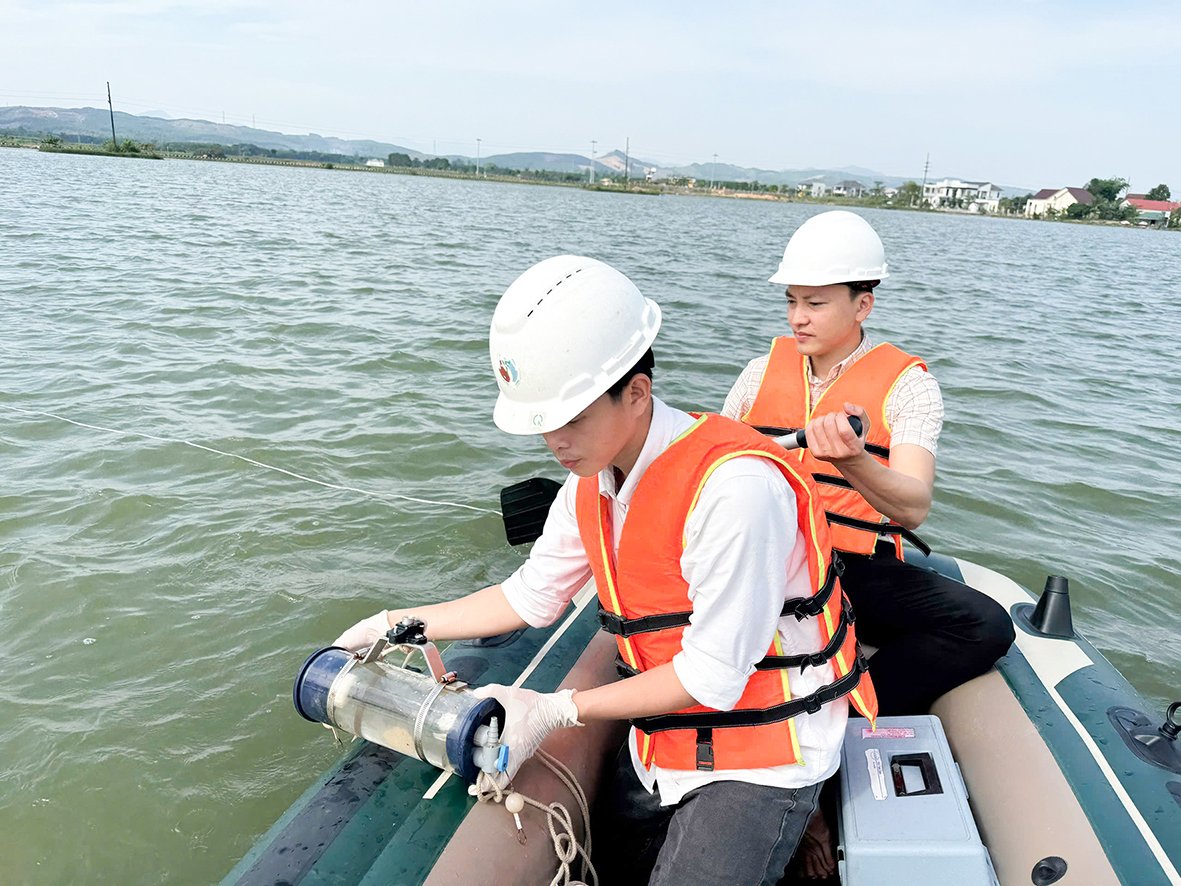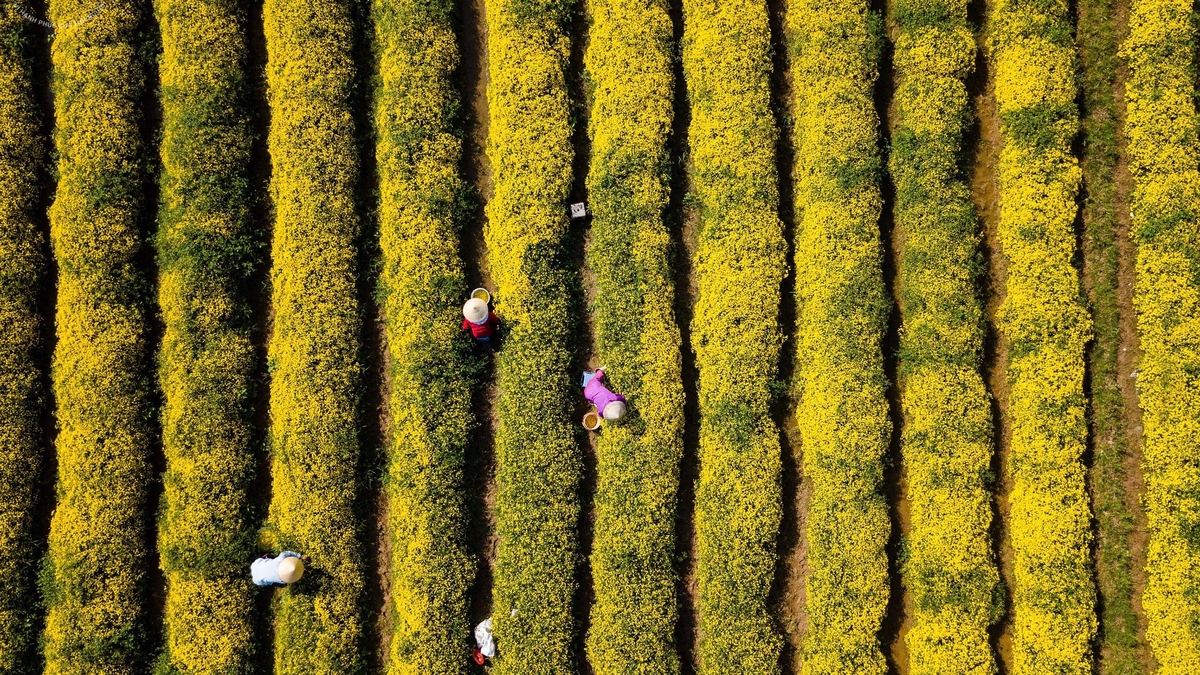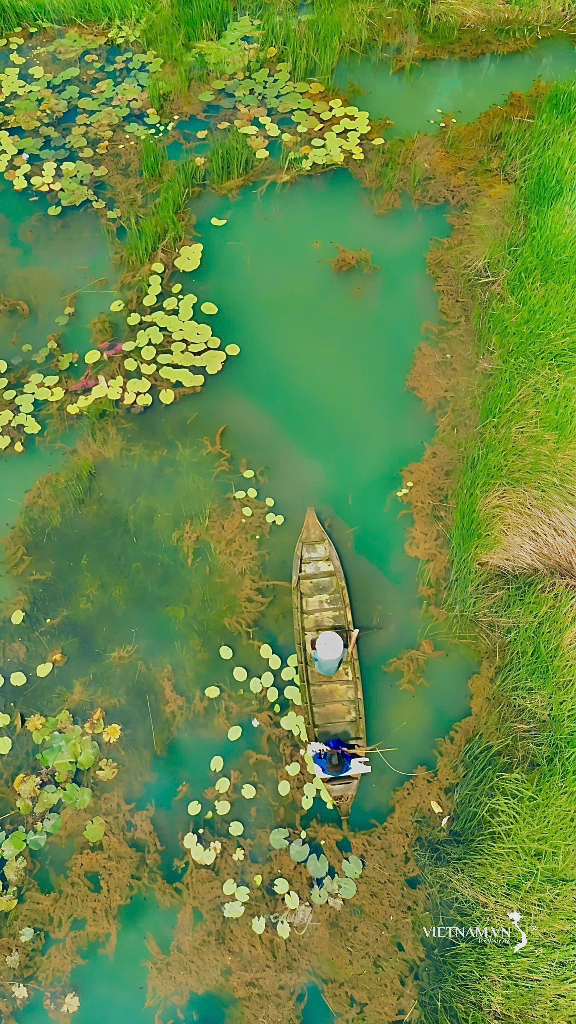Officials from the Center for Resource and Environmental Monitoring are taking samples from the ecological lake in Cam Lo town to analyze and monitor the changes in surface water environmental indicators and components. - Photo: TN
In 2024, the Department of Agriculture and Environment conducted resource and environmental monitoring at 190 locations, with a frequency of 10 times/year for surface water, 6 times/year for seawater and air; 2 times/year for wastewater, groundwater, soil, and sediment; and 1 time/week (from March to August) for saltwater intrusion. The monitoring results promptly detected and warned of pollution cases, providing information and data to support environmental protection and socio-economic development in the locality.
Based on the 2024 monitoring results and the current state and evolution of river water quality, water use purposes have been classified into three main categories, consistent with local realities: water supply for domestic use, water supply for irrigation, and water supply for brackish water aquaculture and other equivalent purposes.
The water quality of most lake monitoring locations falls within the limits of Table 1 according to QCVN 08, posing no health risks when surface water is directly used by humans (without treatment) for various purposes. Except for NH4-N and NO2-N parameters in urban lakes such as Khe Chè, Nam Hào, Lao Bảo, Đại An, Khe Sanh, Khe Mây, Tân Độ, and the Gio Linh town ecological lake, which exceed the limits, the water quality may pose health risks when used directly by humans (without treatment).
The quality of coastal seawater, with most monitored parameters, falls within the permissible limits according to QCVN 10:2024/BTNMT. The seawater quality is suitable for environmental protection, human health, and other equivalent purposes. Seawater quality results during the 2020-2024 period were relatively stable with little fluctuation. There are no signs of pollution in the seawater.
However, with the province's socio-economic development orientation for the period 2021-2030 focusing on building the Southeast Quang Tri Economic Zone in the coastal area of the three districts of Gio Linh, Trieu Phong, and Hai Lang; and simultaneously developing the marine economy in conjunction with the formation of a coastal urban axis, regular monitoring is necessary to track the current state and changes in the quality of coastal seawater.
Soil environmental quality at monitoring locations in 2024 and the period 2020-2024 shows that heavy metal parameters and pesticide residues at all monitoring locations are within the permissible limits of QCVN 03:2023/BTNMT (QCVN 03) and meet the requirements for various purposes.
Groundwater quality at most monitoring locations shows no signs of pollution in terms of heavy metals, microorganisms, minerals, and organic compounds. Most monitored parameters are within the permissible limits according to QCVN 09:2023/BTNMT (QCVN 09). Groundwater quality during the 2020-2024 period generally remained relatively stable and showed no significant fluctuations.
However, in the shrimp farming areas of Trieu Van commune (formerly) (NN30b) and Trieu An commune (formerly) (NN30), groundwater quality has significantly deteriorated due to salinization, with mineralization parameters exceeding the permissible limits according to QCVN 09. In some locations, such as the shrimp farming areas of Trieu An commune (formerly) (NN30) and Trieu Van commune (formerly) (NN30b), the parameters of oxidation, sulfate, hardness, and total dissolved solids show signs of exceeding the permissible limits and this has been repeated for many years.
The quality of urban wastewater in 2024 largely fell within the permissible limits according to column B of QCVN 14. However, the parameters TSS, TDS, BOD5, and Coliform in some urban areas such as Cua Tung, Ai Tu, Hai Lang, Cam Lo, Ben Quan, Lao Bao, Cua Viet, and Khe Sanh showed significant fluctuations across the two monitoring periods (rainy and dry seasons) and exceeded the permissible limits according to QCVN 14:2008/BTNMT (QCVN 14).
During the period 2020-2024, urban wastewater showed significant fluctuations between years and between monitoring locations. Monitoring data also indicates that domestic wastewater in most urban areas is discharged into the same system as rainwater collection and into inner-city lakes. Except for Dong Ha City and Quang Tri Town, which have centralized collection and treatment systems, there are still roads and areas that are not yet connected to these systems. Therefore, strict control of wastewater quality is necessary before discharge into the environment.
Air quality in 2024 and the period 2020-2024 showed no signs of pollution by toxic gases (SO2, NO2, O3, CO). Most air quality monitoring parameters were within the permissible limits according to QCVN 05, QCVN 26, and QCVN 27. However, total suspended particulate matter, PM10 dust, and noise levels at some locations along major transportation routes such as National Highway 1 and National Highway 9 were approximately at or exceeded the permissible limits at certain monitoring times, especially during the dry season months.
All toxic gas parameters (SO2, NO2, CO) at monitoring locations in urban, rural, and industrial park areas are within permissible limits. Air quality monitoring results in urban areas are higher than those in industrial parks, clusters, and rural areas. In 2024, total suspended particulate matter (SPF) levels showed a sudden spike in the La Lay International Border Gate area.
In 2025, resource and environmental monitoring will continue to be implemented stably according to the province's program, while updating and adjusting some content to comply with regulations, such as: not monitoring surface water resources due to overlapping content according to Decision No. 289/QD-TTg dated April 8, 2024 of the Prime Minister on approving the National Meteorological and Hydrological Station Network Planning for the period 2021-2030, with a vision to 2050.
Groundwater resource monitoring: 2 times/year (dry season: once every 3 days, equivalent to 10 times/month; rainy season: once every 6 days, equivalent to 5 times/month) (Adjusted according to the regulations of Decree No. 53/2024/ND-CP). In addition, the Department of Agriculture and Environment is increasing investment in automatic monitoring stations to continuously monitor and promptly control environmental quality in areas at risk of being affected by socio-economic development activities such as the La Lay International Border Gate area and the Sa Lung River.
Increase the frequency of quality monitoring at locations where environmental incidents frequently occur, taking into account feedback from residents in the province, in order to monitor the current state and changes in environmental quality and minimize impacts on human health.
Maintain and improve the construction of environmental monitoring databases in the province, ensuring uniformity, synchronization, and interoperability with the national environmental information system and database, and publish information on local environmental quality based on annual monitoring results.
Tan Nguyen
Source: https://baoquangtri.vn/nang-cao-vai-role-of-resource-and-environmental-management-activities-for-life-193115.htm





![[Photo] Prime Minister Pham Minh Chinh presides over a meeting on private sector economic development.](/_next/image?url=https%3A%2F%2Fvphoto.vietnam.vn%2Fthumb%2F1200x675%2Fvietnam%2Fresource%2FIMAGE%2F2025%2F12%2F20%2F1766237501876_thiet-ke-chua-co-ten-40-png.webp&w=3840&q=75)

![[Photo] Prime Minister Pham Minh Chinh presides over the conference announcing the establishment of the International Finance Centre in Vietnam.](/_next/image?url=https%3A%2F%2Fvphoto.vietnam.vn%2Fthumb%2F1200x675%2Fvietnam%2Fresource%2FIMAGE%2F2025%2F12%2F21%2F1766309817714_ndo_br_dsc-3400-jpg.webp&w=3840&q=75)





























































































Comment (0)